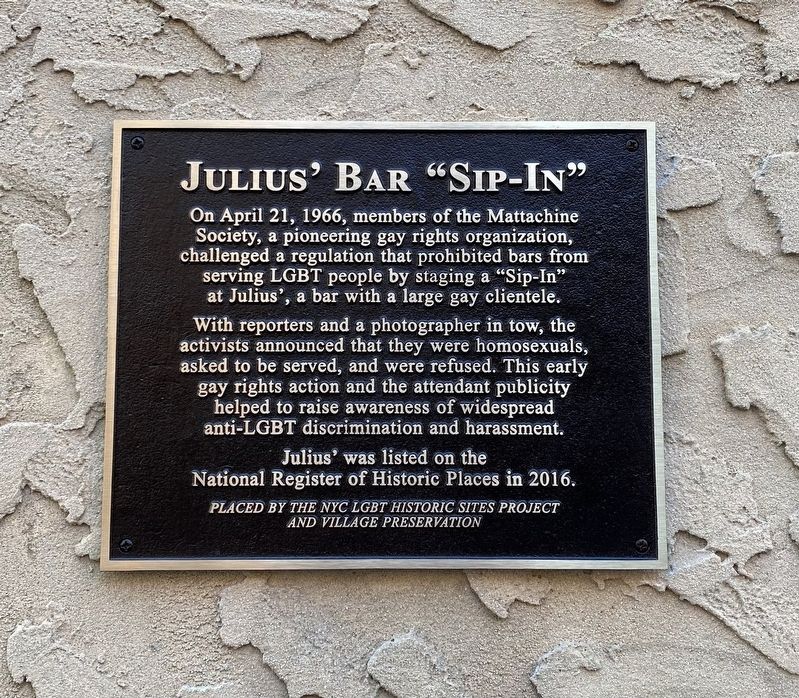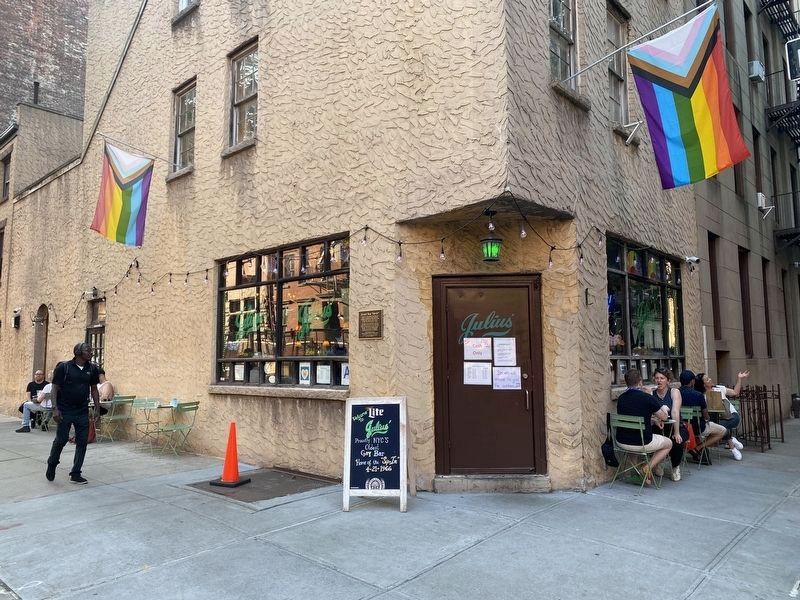West Village in Manhattan in New York County, New York — The American Northeast (Mid-Atlantic)
Julius' Bar "Sip-In"
With reporters and a photographer in tow, the activists announced that they were homosexuals, asked to be served, and were refused. This early gay rights action and the attendant publicity helped to raise awareness of widespread anti-LGBT discrimination and harassment. Julius' was listed on the National Register of Historic Places in 2016.
Erected 2022 by NYC LGBT Historic Site Project, Village Preservation.
Topics and series. This historical marker is listed in these topic lists: Civil Rights • Industry & Commerce. In addition, it is included in the Greenwich Village Society for Historic Preservation series list. A significant historical date for this entry is August 21, 1966.
Location. 40° 44.072′ N, 74° 0.091′ W. Marker is in Manhattan, New York, in New York County. It is in West Village. Marker is at the intersection of West 10th Street and Waverly Place, on the right when traveling west on West 10th Street. Touch for map. Marker is at or near this postal address: 159 West 10th Street, New York NY 10014, United States of America. Touch for directions.
Other nearby markers. At least 8 other markers are within walking distance of this marker. McCarthy Square (within shouting distance of this marker); Brave men, women and worthy patriots dear to God and famous to all ages (within shouting distance of this marker); 27 Christopher Street (within shouting distance of this marker); Northern Dispensary (about 300 feet away, measured in a direct line); FDNY House 18 9/11 Memorial (about 300 feet away); Stonewall Inn (about 300 feet away); a different marker also named The Stonewall Inn (about 300 feet away); Ephraim Ellsworth and the New York Fire Zouaves (about 300 feet away). Touch for a list and map of all markers in Manhattan.
Also see . . .
1. History (Julius Bar).
Excerpt: "During Prohibition, our bar was a popular speakeasy, and along with Nick's at the corner of Seventh Avenue South and the nearby Village Vanguard, was frequented by many of the jazz and literary legends of the era. It started to attract a gay clientele in the 1950s and is the oldest gay bar in the city and the oldest bar in the village."(Submitted on May 25, 2022.)
2. Julius' Bar (National Park Service).
Excerpt: "The sip-in was part of a larger campaign by more radical members of the Mattachine Society to clarify laws and rules that inhibited the running of gay bars as legitimate, non-mob, establishments and to stop the harassment of gay bar patrons. When Dick Leitsch, Craig Rodwell, John Timmons, and Randy Wicker announced that they were homosexuals and asked to be served a drink, the bartender at Julius’ refused their request. This refusal received a great deal of publicity, including articles in the New York Times and the Village Voice, at a time when issues involving discrimination against gay people were not generally discussed in the press. The reaction by the State Liquor Authority and the newly empowered New York City Commission on Human Rights resulted in a change in policy and the birth of a more open gay bar culture.(Submitted on May 25, 2022.)
Scholars of gay history consider the sip-in at Julius’ as a key event leading to the growth of legitimate gay bars and the development of the bar as the central social space for urban gay men and lesbians."
3. Julius’ Bar, an LGBT Landmark (Village Preservation). On the effects of the "sip-in"...
"The next day The New York Times covered the incident; the headline of the article referred to the three participants as “sexual deviates,” illustrating the widespread perception of homosexuality at that time. However, as Leitsch states above, the event marked a rare yet monumental moment when the gay community chose to speak out against the discrimination they had faced for generations. After they were refused service, the three men filed a complaint with the city’s Commission on Human Rights. This led to a 1967 state court ruling that declared the SLA needed “substantial evidence” of indecent behavior to close a bar and not just same-sex kissing or touching. The decision was a landmark case that reversed years of discrimination and became a key catalyst in the eventual gay rights movement beginning in 1969."(Submitted on May 25, 2022.)
Additional keywords. lgbt lgbtq 🏳️🌈
Credits. This page was last revised on May 31, 2023. It was originally submitted on May 25, 2022, by Andrew Ruppenstein of Lamorinda, California. This page has been viewed 125 times since then and 28 times this year. Photos: 1, 2. submitted on May 25, 2022, by Andrew Ruppenstein of Lamorinda, California.

